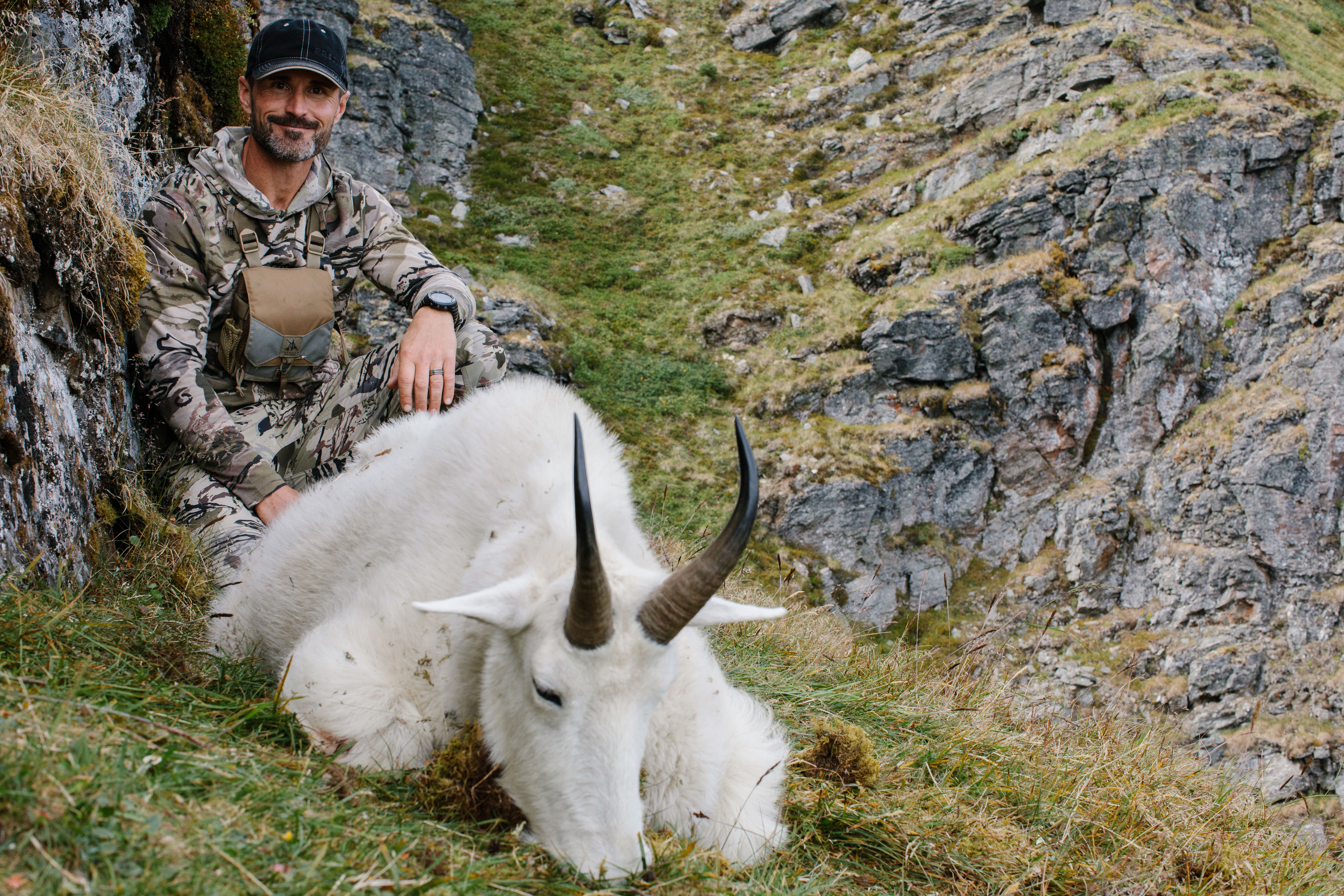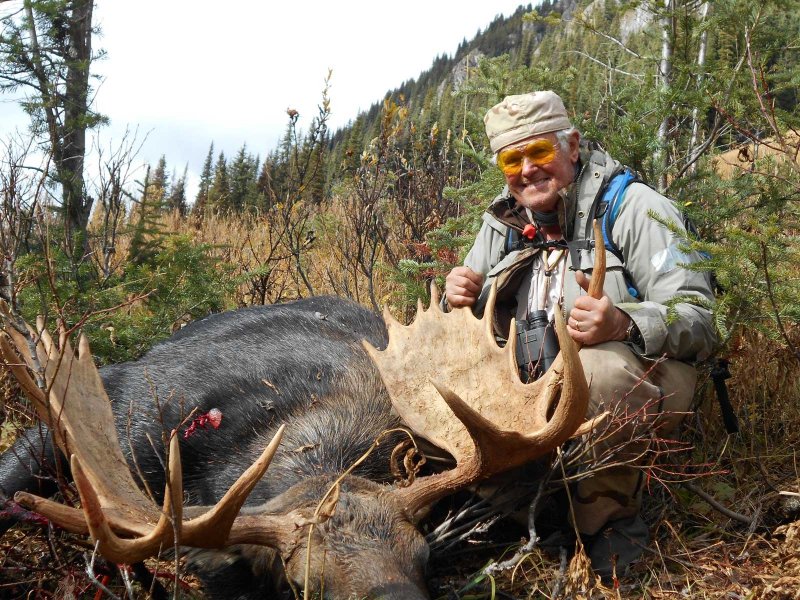HUNT ITINERARY
Upon your arrival in Ft. Grahame you will be greeted by someone from Finlay River Outfitters. We will find you a bunk for the evening unless you are heading straight to spike camp. You will be fed lunch and you will check your rifle next. We prefer your rifle to be sighted in 3 inches high at 100 yds and you should have a .270Win or larger.
The next day you will travel to your spike camp. Where you go will depend on what species you are hunting and your physical capabilities. You may move to different camps for other species.
Your last night will be spent in Ft. Grahame before your return to Prince George. We will get your trophies ready for your return home or if you wish we will have them shipped to you or your taxidermist at the end of the season. In some cases this is easier as there are compulsory inspections for some species and others need C.I.T.E.S. permits applied for.

Fall Hunts – Elk, Moose, Caribou, Mountain Goat, Whitetail and Mule Deer
Primary animals: Elk, Moose, Caribou, Mountain Goat, Whitetail and Mule Deer. The morning after you arrive at Ft. Grahame your hunt begins. You then hunt for 10 days and return home. On a fall hunt you are allowed to hunt any one of the primary animals. After success on your first choice, you may choose to hunt a second primary animal. If you are successful on your second animal a trophy fee will be charged. All hunters on fall hunts may hunt black bear and wolf at no extra charge.
ELK
Our elk hunts are conducted during the rut which occurs from about the first of September until near the last of September. This is the very best time to hunt elk. During the rut the bull elk are very vocal in their search for cows and can be called using both bull and cow calls.
There is a growing population of elk and they are expanding their range throughout the area. The mature bulls tend to have large, heavy antlers. There is also a six point restriction on the bulls which gives the smaller bulls a chance to reach maturity and a better prospect of harvesting a trophy bull. Hunting elk when they are bugling is a very exciting hunt and they make a very impressive trophy.

STONE SHEEP
Our quota for Stone Sheep is 7 rams in 5 years. We have a small population of Stone Sheep in our area which is reflected by our small quota. We have found sheep where they have not been hunted historically and we are confident we will be harvesting some rams in the immediate future.
If you may be interested in hunting sheep please feel free to contact us. We will be offering an opportunity to hunt sheep at a very fair price to an interested individual.

MOUNTAIN GOAT
As a primary animal we hunt goats in September and early October. In later October the weather can become very difficult and the steep slopes the goats inhabit can become snow covered and extremely dangerous.
We offer two different types of goat hunts. We have a horse back hunt that we use horses to get to goat hunting areas. We also have back pack hunts where the goat hunting areas are accessed on foot.
The horse back hunt gets us to remote areas that are very hard to access on foot because of difficult terrain to traverse including rivers to cross. The horses allow us to get into these areas and also give us the flexability to change hunting areas should it become necessary.
The back pack hunt we employ to hunt areas and stay up on the mountain without having to come down and care for the horses. Whichever way we decide to hunt goat hunting is a very physical pursuit and all hunters should be in very good condition.
We try extremely hard to harvest only mature Billys. Most goats we harvest are over 9 inches, our largest being a Billy that scores 53 1/2”

MOOSE
The most successful time for hunting moose is during the rut which starts in late September, about the 25th, and runs through late October until the 20th or so. During the rut moose will come to a call which makes it easier to provide a good opportunity to harvest a good bull.
We hunt moose using several different methods. To access our more remote moose country we need to use horses as this is the only mode of transportation compatible to reach these spots which see very little human influence. We can also access remote moose hunting using a riverboat for those who aren’t horse compatible. We also have less remote moose hunting that can be reached by ATV or a combination of ATV and boat.
The average spread of the moose we harvest is between 45 and 55 inches however on occasion we do take larger and smaller bulls, our largest being 65 inches.

BLACK BEAR
We hunt black bear in both spring and fall. The best time in the spring is from mid May until the 15th of June. The best time to hunt in the fall is September 1 until October 15th. It is quite common to see as many as 20-30 black bears during a week hunt during the spring therefore the area has a bag limit of two black bears.
In the spring the black bear are quite often found foraging where the can find new green growth. A lot of time is spent glassing mountain slopes that get exposure to sunlight and make the grass grow. If bears find a spot where they like to eat they will quite often frequent the same spot for several days especially in the evening. Bears also mate from late May and into Mid June. The large boars will travel at this time of year in search of mates and for this reason they become more visible.
Fall hunts are the same except instead of the bears looking for green growth they are looking for ripe berries. In some spots the huckleberries grow as large as your thumbnail and the bears return to these spots to gorge themselves and gain as much weight as possible in preparation for winter hibernation.

WOLF
Wolves are usually a very difficult animal to hunt. They are a very wary illusive animal and if they present an opportunity it usually doesn’t last long. Most wolves that are harvested are taken when an opportunity presents itself while pursuing other game animals. However, winter does offer a great chance to hunt wolves.
Because our base camp is also our residence and we are present throughout the year we have a unique opportunity to hunt wolves. We have about 80 to 90 miles of Williston Lake which is the largest lake in British Columbia in our area. When the lake freezes the ice provides an easy travel corridor for the wolves. During the winter we can maintain several different bait sites along the ice that the wolves will frequent. Although it is an isolated area we can access the ice from two of our camps that are alongside the lake with snowmobiles which gives us the mobility we need to successfully hunt the wolves. There are also other species that can be hunted at different times throughout the winter such as lynx and wolverine.



Contact Us
Main Contact - Jordy McAuley
Cell: 780-835-0385
Secondary Contact - Erika Bowing
Cell: 250-990-0222
